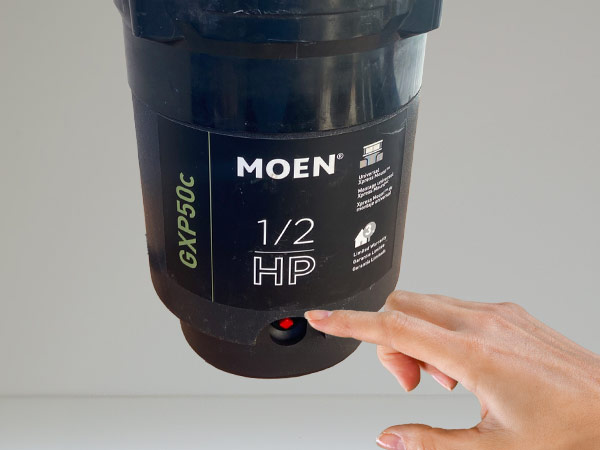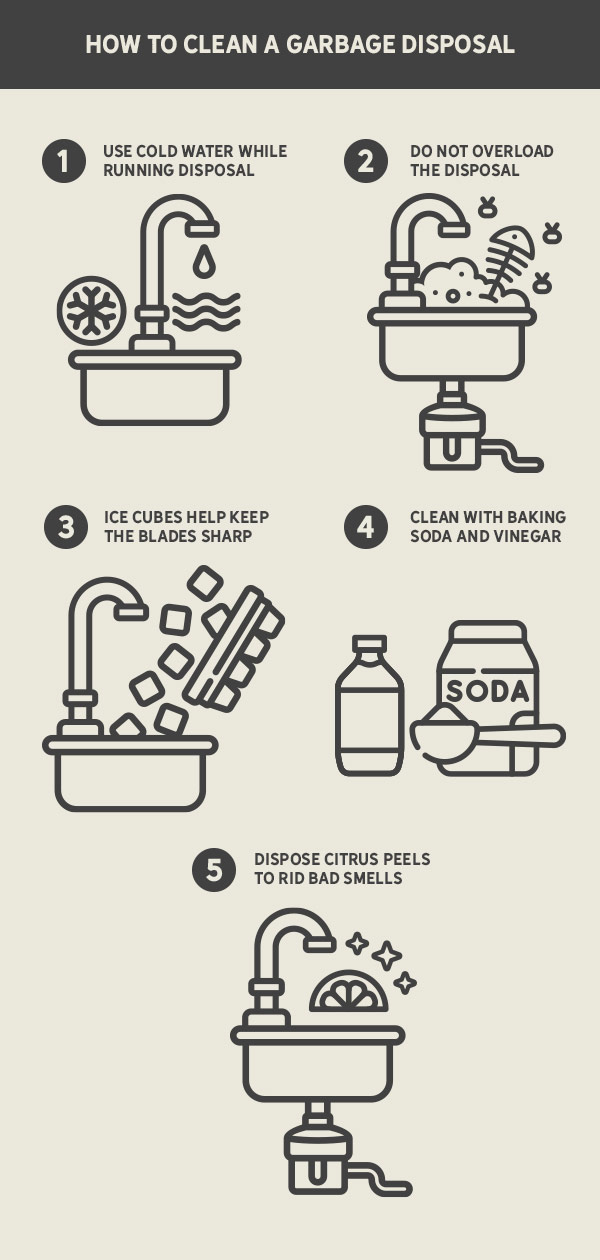

Garbage Disposal Not Working? Get it Fixed Now.
You flip the switch and all you hear is the dreaded garbage disposal hum. You have a clog somewhere down there. Thankfully, most issues are easy to fix, and only simple tools are required. Whether you have a clog, leak, or need to know how to clean your garbage disposal (what is that smell?), follow our guide to keep those blades spinning.
Repair Safety
A garbage disposal’s job is to tear and grind food scraps and waste with the cutter wheel and heads and small teeth. All this spins fast to break down anything from vegetables to small bones. Before anything else, remember that during repairs, a certain amount of caution is needed to keep your fingers safe. Follow these two rules:

- Never put your hand down the disposal into the grinding chamber. Use tongs to grab any clog. If you must use your hands, wear rubber dish gloves, and turn off the power to the unit completely.
- Before any inspection or repairs to the unit, turn the power to the garbage disposal off— preferably at the utility panel. Only turn the power back on when it’s time to test after repairs.

4 Issues and Their Solutions
- Won't turn on? Start with the basics. Check to see if your unit is plugged in and if the switch is on. A large amount of food waste could have triggered the circuit breaker, so check the circuit breaker panel switch and reset it.
Garbage disposals also have their own reset button and circuit breaker to keep the unit from overheating. This is a button usually underneath the disposal. Press the reset button if it popped out. If there still seems to be an electrical issue, it is best to call an electrician for further investigation.
- Clogged? Humming? If your garbage disposal makes a sound, it’s not an electrical issue but more mechanical in the form of a clog or other obstruction. Don’t continue to try to run the disposal to dislodge the clog as this could overheat the unit. If you can see the clog or suspect it to not be too dense, try using tongs to remove it or use the trusty vinegar and baking soda trick.
If that doesn’t solve the problem, move the cutter wheel to break up the clog. Most manufacturers will have a hex key to help with this or you can grab one from your toolbox. Insert the hex key in the bottom slot underneath the unit and turn it back and forth. This motion will help to dislodge the clog. Keep moving it back and forth until you don’t get any more resistance.
If you don't have a hex key or need more force, use two broom handles. Put them in the sink drain on both sides of the cutting wheel and turn them back and forth. If dislodging the clog doesn’t work, it may be time to call in a professional or replace the unit entirely.
- Leaking from the top? Leaking from the top near the sink flange is a quick fix. Just like you have to re-caulk around your windows, the connection from the unit to the sink needs some extra plumber’s putty after years of use. Unmount the disposal and apply a new bead of putty around the flange and install back making sure the connections are tight. Run the disposal to check if that solved the issue. If the dishwasher hose connected to the disposal is leaking, you may either need to tighten it or replace it.
- Leaking from the bottom? If your garbage disposal is leaking from the bottom of the unit (like water coming out of the reset button), it’s time to get it replaced. There could be cracks or other holes that have formed and while they may be able to be fixed temporarily with plumber’s putty, it’s not a permanent solution.

How to Clean a Garbage Disposal and Other Maintenance

Garbage disposals can last anywhere from eight to 15 years with proper maintenance. From keeping the cutters sharp to getting rid of stinky smells to what not to grind, follow these tips and tricks:
- Only use cold water when running the disposal. Running your unit every day will keep the cutter wheel from getting rusted, but do so with cold water. Don’t dispose of any fat like a piece of pork chop fat or even cooking oils in the unit. Hot water will liquify the fat, causing it to stick to the blades or somewhere down the line, resulting in a clog. Cold water will keep things moving.
- Don't overload the unit. While a simple concept, only about a cup or less of waste should be disposed of at one time. Cut up larger portions and send them down the disposal a little bit at a time. Too much waste will overload the unit and cause it to throw its breaker making you go back to the top of this article for a fix.
- Use ice cubes to keep the blades sharp. Grinding up a cup of ice with hot water can help to loosen any clog that you’ve got forming but it will also help to keep the blades sharp. Hot water here will help clear out the pipes- just don’t use hot with waste. It's a good idea to send ice down once a month. You can even add some rock salt into the mix to clear out unwanted smells.
- Clean with baking soda and vinegar mixture. For a deep clean, a mixture of a cup each of baking soda and vinegar every two to four weeks can keep the disposal and further down the drain clean and clear. While you’re at it, use a small brush or a toothbrush (earmarked for cleaning only) to scrub down the rubber flaps.
- Dispose citrus peels to get rid of bad smells. To keep bad smells at bay, send down anything citrus like lemon, lime, orange, or grapefruit peels. You can even keep the scrap peels in the freezer until you need one. Be sure to cut the peels down to a manageable amount and use hot water to cut up any accidental leftover grease.
What to put down your garbage disposal:
- Fruit and veggie scraps
- Small bones
- Small amounts of pasta
What NOT to put down your garbage disposal:
- Fats
- Large bones and shells
- Large amounts of rice or pasta (anything starchy)
- Large portions of food in general
- Coffee grounds
We have everything you need for that kitchen sink (the sink, too, if you need one) and the tools needed to keep your garbage disposal running. Just generally need some advice to keep things flowing? Stop by your local McCoy’s, where we’re happy to discuss garbage disposal tips and tricks. No time to shoot the breeze? Use our buy online and pickup in-store option to grab your materials and get back to fixing that clog so you can get back to what matters—building!
